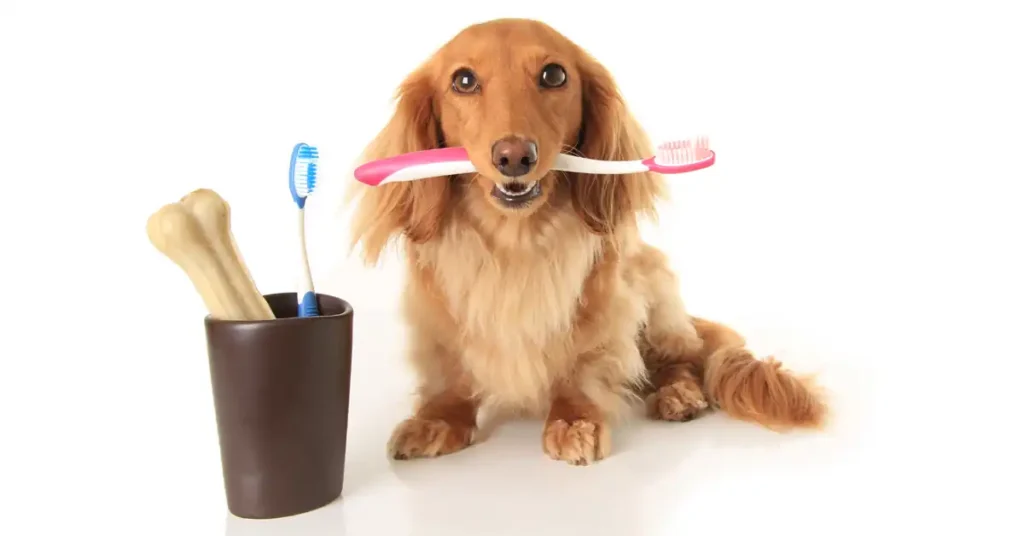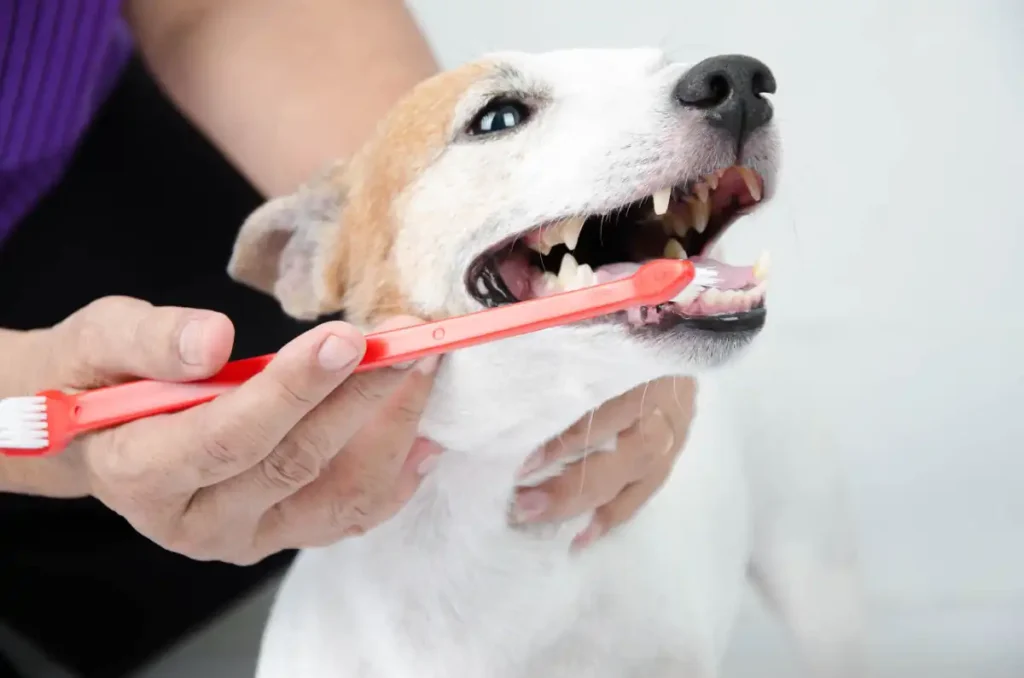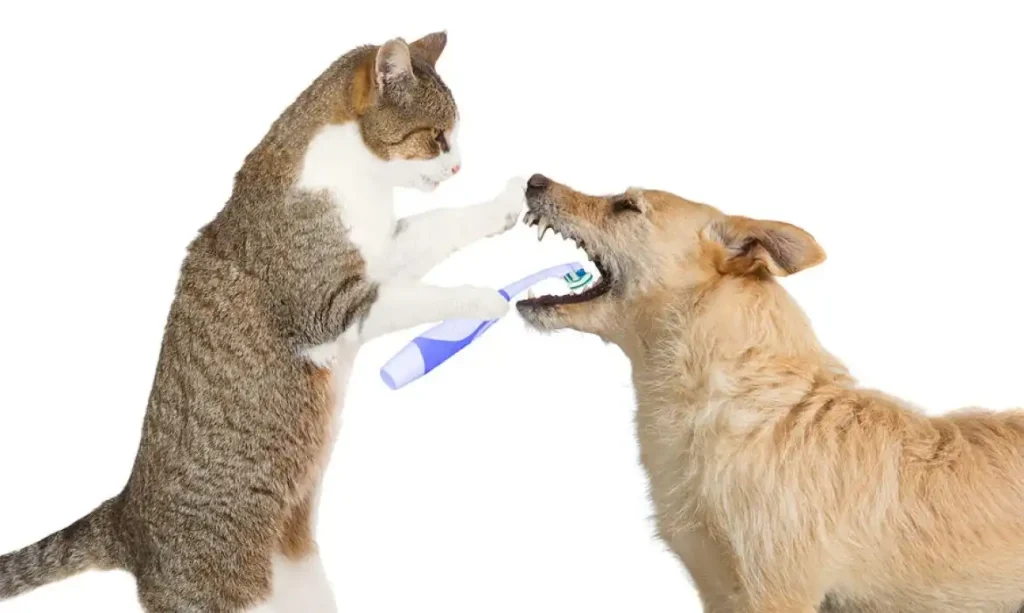According to statistics, more than 90% of dogs and cats over one year old suffer from periodontal disease. Dr. Brook Niemiec, an authoritative American veterinary dental specialist, even pointed out that most furry children’s oral problems, such as tooth decay, periodontal disease, etc., are caused by Neglect of oral care at home is caused by neglect, so it is very important to develop the habit of brushing the teeth of cats and dogs. Only by taking good care at home can you protect the oral health of cats and dogs. Next, follow the steps of this article to understand the dental health problems of cats and dogs and the 8 steps of correct tooth brushing. , do a good job of oral health care for your furry baby carefully.

Why do cats and dogs have periodontal disease on their teeth?
Plaque accumulation is the main cause of periodontal disease. It only takes 24 hours for plaque to form, 3 days for dental calculus to form, and 2 weeks for the gums to become inflamed. That is to say, if we don’t take good oral care of our furry kids, our beloved furry kids will suffer from it throughout the year. There are 50 weeks (350 days) of exposure to the risk of oral infection. In addition, once calculus begins to accumulate on your dog’s teeth, the calculus will also cause uneven tooth surfaces, becoming an accomplice to the accumulation of bacteria, further causing gum inflammation, and even aggravating periodontal disease.
What complications can periodontal disease cause?
When oral problems become more and more serious, in addition to causing problems such as loss of appetite, slower eating speed, anorexia, etc., if bacteria enter the body of the furry through the mouth, they can reach the furry’s heart, liver, kidneys, lungs and other important organs through blood circulation. , may also cause infections of these organs, such as bacterial endocarditis, and heart valve disease related to oral problems.
Severe periodontal disease may cause the following three complications:
1. Palate: Oronasal and Chronic Nasal Diseases
2. Mandible: Pathological mandibular fracture
3. Systemic: organ system abnormalities and systemic diseases
Why do dogs have tartar?
Just like humans, dogs have saliva, which contains bacteria that will attach plaque to the surface of the teeth over time and accumulate with food debris to calcify into tartar. Tartar can irritate your dog’s gum tissue, causing edema and congestion, which can lead to bad breath, gingivitis, and further periodontal disease and stomatitis.
Dogs with periodontal disease not only have difficulty taking in nutrients, they also have an increased risk of diabetes, heart or kidney disease. Therefore, it is recommended to bring your dog to the veterinary hospital as soon as possible to avoid worsening the symptoms of oral disease.
How to remove tartar in dogs? How much does it cost?
To remove tartar from your dog’s teeth, you will need to have a scaling, formally known as “periodontal therapy”, which consists of a periodontal clinic visit to evaluate the bite, full mouth x-rays, a periodontal probe and a surgical procedure under anesthesia.
The first step is to do a pre-surgical risk assessment of the dog’s physiological condition, perform blood tests or necessary imaging tests depending on the dog’s condition, and select the appropriate anesthesia according to the risk level of anesthesia. General anesthesia is required for the treatment process, along with endotracheal intubation, to avoid aspiration pneumonia due to backflow of water during scaling.
After examining the entire mouth and making dental records, the veterinarian will use an ultrasonic scaler and dental instruments to remove calculus and plaque from the surface of the teeth and the periodontal pockets, then use a dental probe to check the periodontal tissues and the depth of the pockets, and take dental X-rays to determine whether advanced treatment is needed; in the case of severe looseness, extraction may be necessary.
Veterinarians recommend that dogs have a dental checkup every six months and periodontal therapy every one to two years. Periodontal treatments vary in price for different sizes of dogs, depending on blood tests, anesthesia methods, anesthesia hours, and other additional treatments, ranging from a few thousand dollars to tens of thousands of dollars.
How to take care of your dog’s oral health at home – 8 steps to help your dog’s furry friends who don’t like brushing their teeth

Although we all know that brushing your dog’s teeth is the gold standard for protecting oral health and maintaining a fresh breath, brushing your dog’s teeth is often not an option for those who don’t like to brush their teeth, which can lead to periodontal disease, heart and kidney disease over time. The following is a compilation of tools needed for brushing cats’ and dogs’ teeth, as well as 8 steps for proper brushing, to help you protect your furry child’s oral health.
What tools should I prepare before brushing my cat’s or dog’s teeth? Pet toothpaste, toothbrush, and chewable tablets
Prepare the following 4 tools before you start brushing:
1. Toothbrush and toothpaste designed for dogs and cats: Choose a soft-bristled toothbrush that fits your dog’s size and mouth, and your dog’s favorite pet toothpaste.
2. VOHC-approved dental chews: If your furry is reluctant to brush his teeth, you can use dental chews to maintain basic oral health.
3. Owner’s strong patience: You must have enough patience when brushing your furry’s teeth, and cultivate the habit of brushing your furry’s teeth in order to effectively maintain a clean mouth.
4. Various kinds of rewards that the furry likes: You can give timely rewards during and after brushing to minimize the furry’s rejection of brushing.
After preparing the above 4 tools, you can start to help the fur child brushing, but pay special attention to is, if the dog already have oral problems, brushing the teeth may have pain uncomfortable feeling, so that the dog produces a sense of resistance, and even hate brushing, so in addition to brushing every day, it is recommended to carry out an oral examination once a year, regular understanding of the fur child’s oral status, and if necessary, receive early treatment.
In addition, since the finger cots do not have bristles, they cannot really clean and cannot completely replace the toothbrush. They can only be used at the initial stage of brushing with the dog, so that the fur child can get used to the feeling of brushing his or her teeth, and when the fur child adapts to the finger cots, he or she will still need to replace the toothbrush gradually in order to clean the fur child’s oral cavity.
8 steps to brush your cat’s or dog’s teeth|Easy to make your furry love brushing!
It’s not difficult to brush your dog’s teeth, but the most important thing is to be consistent and to practice patiently with your dog. You can practice one step every day, and give your dog a reward or a big praise when you finish each action, and after a few days of practice, make sure that your dog accepts the steps before moving on to the next step, so as to slowly make your dog fall in love with brushing his/her teeth!

Here are 8 steps for brushing your cat’s and dog’s teeth, all actions should be slow and gentle, so that your furry child can get used to it and accept it slowly, and if you are too hasty or rude, you may cause your furry child to be scared and fail.
🐕 1. When the furry child sits down, use your hand to approach the face, so that the furry child can get used to the action of approaching the face with your hand first.
🐕 2. Take turns touching each part of the face with both hands.
🐕 3. Slowly touch the mouth and lift up the skin of the mouth (the flesh around the mouth). This is an important part of brushing, so be sure to practice it a lot.
🐕 4. Gently touch your furry child’s teeth and gums.
🐕 5. Begin to introduce the toothbrush to your baby. Approach the toothbrush slowly and gently to your baby, or let your baby approach you, to help him recognize the toothbrush. You may also want to squeeze a scented toothpaste for dogs and cats on top of the toothbrush, as the scent will help the dog accept the toothbrush.
🐕 6. After gently lifting the dog’s mouth, gently touch the toothbrush to the teeth.
🐕 7. When your dog is not resistant to the brush touching his teeth, slowly add in the brushing action, don’t forget to start brushing the front, sides and back of the teeth slowly.
🐕 8. When your dog starts to accept the “brushing” action, you can brush your dog’s teeth more frequently! Brush at a 45-degree angle, 5 strokes to the left and right, and remember to make a “swish” sound to indicate that you have cleaned your dog’s teeth.
In addition to daily brushing, passive care is also essential! Give your dog some teeth-cleaning aids, such as VOHC-approved dental chews, to help clean the areas that brushing can’t reach!
What can I do if my furry kids hate brushing their teeth? Chewable Teeth Maintains Good Oral Health
Although we know that brushing is the gold standard for protecting your child’s oral health, if you have spent a lot of patience and time to cultivate your child’s brushing habit, but your child still rejects brushing, you can help protect your child’s oral health by choosing chewable teeth cleaners with VOHC certification, which is the most credible certification association for passive teeth cleaning products in the world, and is based on the efficacy of the product, its ingredients, its ability to not harm teeth, and whether or not it’s easy to digest. VOHC is the most credible passive dental cleaning product certification association, which can give comprehensive oral protection to children who don’t like brushing their teeth.
